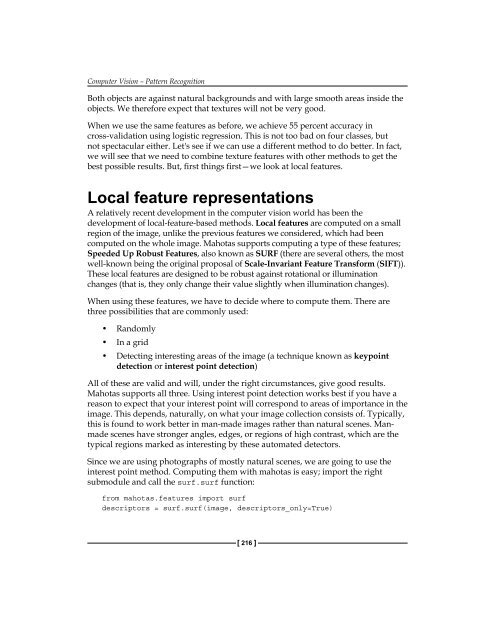1FfUrl0
1FfUrl0
1FfUrl0
You also want an ePaper? Increase the reach of your titles
YUMPU automatically turns print PDFs into web optimized ePapers that Google loves.
Computer Vision – Pattern Recognition<br />
Both objects are against natural backgrounds and with large smooth areas inside the<br />
objects. We therefore expect that textures will not be very good.<br />
When we use the same features as before, we achieve 55 percent accuracy in<br />
cross-validation using logistic regression. This is not too bad on four classes, but<br />
not spectacular either. Let's see if we can use a different method to do better. In fact,<br />
we will see that we need to combine texture features with other methods to get the<br />
best possible results. But, first things first—we look at local features.<br />
Local feature representations<br />
A relatively recent development in the computer vision world has been the<br />
development of local-feature-based methods. Local features are computed on a small<br />
region of the image, unlike the previous features we considered, which had been<br />
computed on the whole image. Mahotas supports computing a type of these features;<br />
Speeded Up Robust Features, also known as SURF (there are several others, the most<br />
well-known being the original proposal of Scale-Invariant Feature Transform (SIFT)).<br />
These local features are designed to be robust against rotational or illumination<br />
changes (that is, they only change their value slightly when illumination changes).<br />
When using these features, we have to decide where to compute them. There are<br />
three possibilities that are commonly used:<br />
• Randomly<br />
• In a grid<br />
• Detecting interesting areas of the image (a technique known as keypoint<br />
detection or interest point detection)<br />
All of these are valid and will, under the right circumstances, give good results.<br />
Mahotas supports all three. Using interest point detection works best if you have a<br />
reason to expect that your interest point will correspond to areas of importance in the<br />
image. This depends, naturally, on what your image collection consists of. Typically,<br />
this is found to work better in man-made images rather than natural scenes. Manmade<br />
scenes have stronger angles, edges, or regions of high contrast, which are the<br />
typical regions marked as interesting by these automated detectors.<br />
Since we are using photographs of mostly natural scenes, we are going to use the<br />
interest point method. Computing them with mahotas is easy; import the right<br />
submodule and call the surf.surf function:<br />
from mahotas.features import surf<br />
descriptors = surf.surf(image, descriptors_only=True)<br />
[ 216 ]


